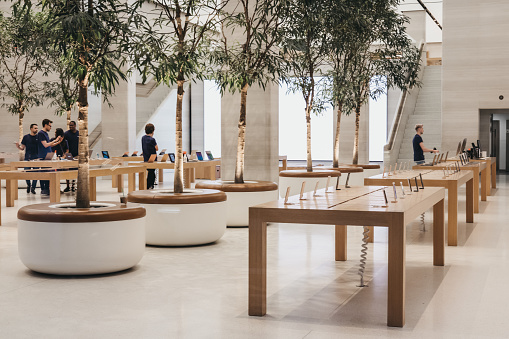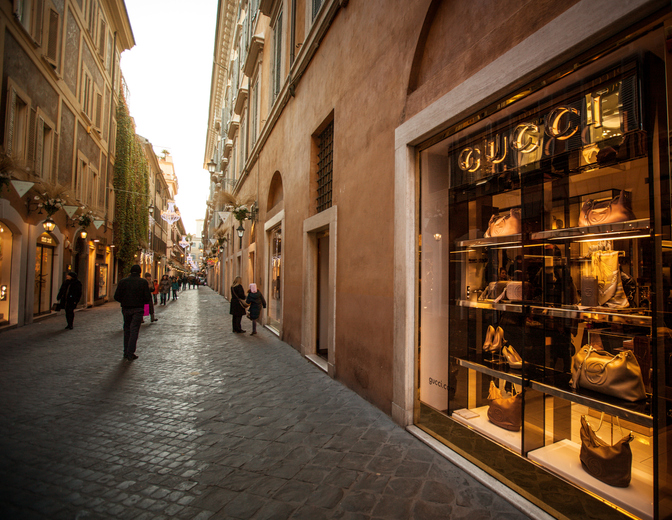Editor’s note: Daniel Sills is associate director at research firm C Space and producer of podcast Outside In, Boston. This is an edited version of a post that originally appeared under the following title, “The physical brand.”
Scott Galloway makes lots of predictions. Some right, some wrong, some kinda right or kinda wrong depending on what side you’re on.
As a marketing professor at NYU Stern, he has a lot of insight into the future of brands – especially when it relates to the companies currently ruling our world: Google, Amazon, Facebook and Apple. Galloway’s book The Four describes why and how each is so successful (and in many ways, unstoppable) and the effects each company will have on our lives – and on business – in the years to come.
It’s not so surprising that each of the four are tech or digital companies. (Isn’t everything digital now?) Galloway was a recent guest on the Outside In podcast. His mind is equal parts encyclopedic and clairvoyant. He’s also really funny. Our lives are being shaped by these West Coast tech giants, he says, and, like it or not, that shape will continue to be formed by machines, algorithms and an exclusive group of super smart people. But what really surprised me during the interview was a prediction he made about the future of marketing: It’s distribution. And it’s physical.
The physical experience
 Marketing is all about “controlling the experience,” he says. More precisely, the retail environment that products live in will have a greater influence on our pre-purchase decisions than traditional advertising. Galloway is pretty blunt with his prediction: “Retail is supposedly dying? I think we’re going to see a massive reallocation of capital out of traditional advertising into distribution. That’s what Apple did. And there’s a ton of people who should think about doing the same thing.”
Marketing is all about “controlling the experience,” he says. More precisely, the retail environment that products live in will have a greater influence on our pre-purchase decisions than traditional advertising. Galloway is pretty blunt with his prediction: “Retail is supposedly dying? I think we’re going to see a massive reallocation of capital out of traditional advertising into distribution. That’s what Apple did. And there’s a ton of people who should think about doing the same thing.”
Apple’s aim was never to be just another tech manufacturer, sold only at Best Buy, Sears or whatever store would have them, where people make rational decisions, asking, “Which of these MacBook features will work for me?” and “Can I really afford this iPhone XS?” Instead, Apple turned itself into a luxury brand. And anyone who has ever aspired to own a little piece of luxury will tell you that functionality, features and value for the money all take a back seat to emotion. Does the Hermès Birkin bag cost as much as some people earn in a year? Yes. But it’s the feeling you’re after. What matters is the way the bag makes you feel and what people who see you with it feel – or how we think they feel. Apple has created that same mystique.
 Part of Apple’s luxury strategy is to create luxurious stores, or as Galloway notes, “Temples for the brand,” a.k.a. the Apple store, which is really like a Gucci or Louis Vuitton store. “It created more shareholder value than any single decision,” he says about Steve Jobs reallocating billions of dollars from Apple’s traditional advertising budget into physical retail.
Part of Apple’s luxury strategy is to create luxurious stores, or as Galloway notes, “Temples for the brand,” a.k.a. the Apple store, which is really like a Gucci or Louis Vuitton store. “It created more shareholder value than any single decision,” he says about Steve Jobs reallocating billions of dollars from Apple’s traditional advertising budget into physical retail.
When I walk into the Apple Store, it feels like an art gallery. Store employees are the docents guiding you through the low-slung labyrinth of white tables displaying the latest in minimalist technological artistry. If you wanted to buy a non-Apple phone, you would have to go to a Verizon or AT&T store, or some other third-party retailer. Often these places feel more like car dealerships for tech products. They’re nice enough, the carpeting is OK and most of the employees are helpful and have their shirts tucked in. But it’s not luxurious. According to Galloway, that affects my perception – and reinforces my romance with Apple.
Our physical experience with a brand is the brand. In our digital world, physical is disruptive. We’ll all continue to buy online but our physical encounters will shape our perceptions and decisions, inspiring us to say, “Alexa, buy me more Crest whitening toothpaste” rather than, “Alexa, buy me some toothpaste that makes my teeth whiter.”
Sure, opening a whole bunch of stores to sell your products may work for companies like Microsoft, PepsiCo or Samsung. Will we see product stores for everything we buy? Probably not. But there are other ways for brands to get physical.
A lasting impression
Brands can start small and create physical experiences that a consumer may only have once in their journey but that leave a lasting impression. That’s what Chobani is doing with its Chobani Cafés in New York’s SoHo and TriBeCa neighborhoods. You can buy breakfast, lunch or dinner at the café. But the purpose is to celebrate the product in a hip NYC café scene, to teach us that it’s OK to mix avocados with yogurt and that the Chobani brand encompasses more than just yogurt.
Or, you can go big and host memorable events that are gathering places for fans – making it less about selling products and all about celebrating the community that loves them. Hasbro, for example, has its annual HasCon. Families are invited for a three-day weekend at Hasbro HQ where they get to dress up like Transformers, see the latest in Play-Doh innovation, hang with Mark Wahlberg and meet toy and game designers. When they think of the Hasbro brand, they remember the awesome time they had at HasCon.
There’s another area that has a huge influence on the physical encounters we have. The people we meet. The employees. I’m reminded of another recent Outside In episode with Bluemercury co-founder and COO, Barry Beck. He told us that the beauty retailer (which sells its own products, too) deliberately hires “beauty junkiesˮ to staff its physical stores. They aren’t just helpful and friendly to customers, they’re legitimately obsessed with beauty products. They act like personal beauty consultants. Google or customer service bots can’t replicate that. Its “junkies” are a big reason why Bluemercury is enjoying so much success right now.
Transition to physical
The transition to physical won’t always be easy for marketers. That alone should tell them that it’s worth doing! I’ll tell you this: it will be a lot more fun and creative and experimental than buying ad space. I’m excited to see what brands can do. I’ll be there in person.
